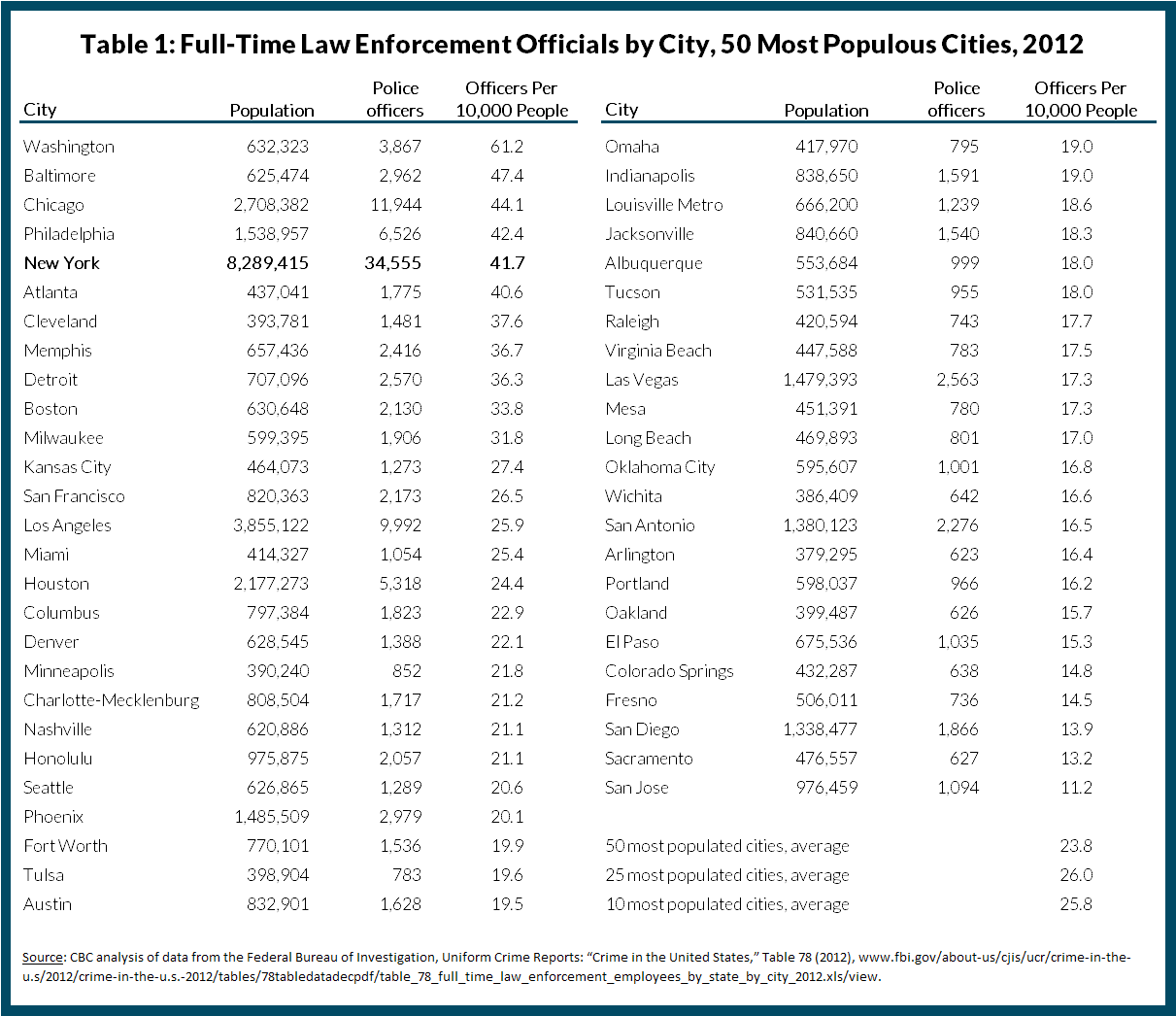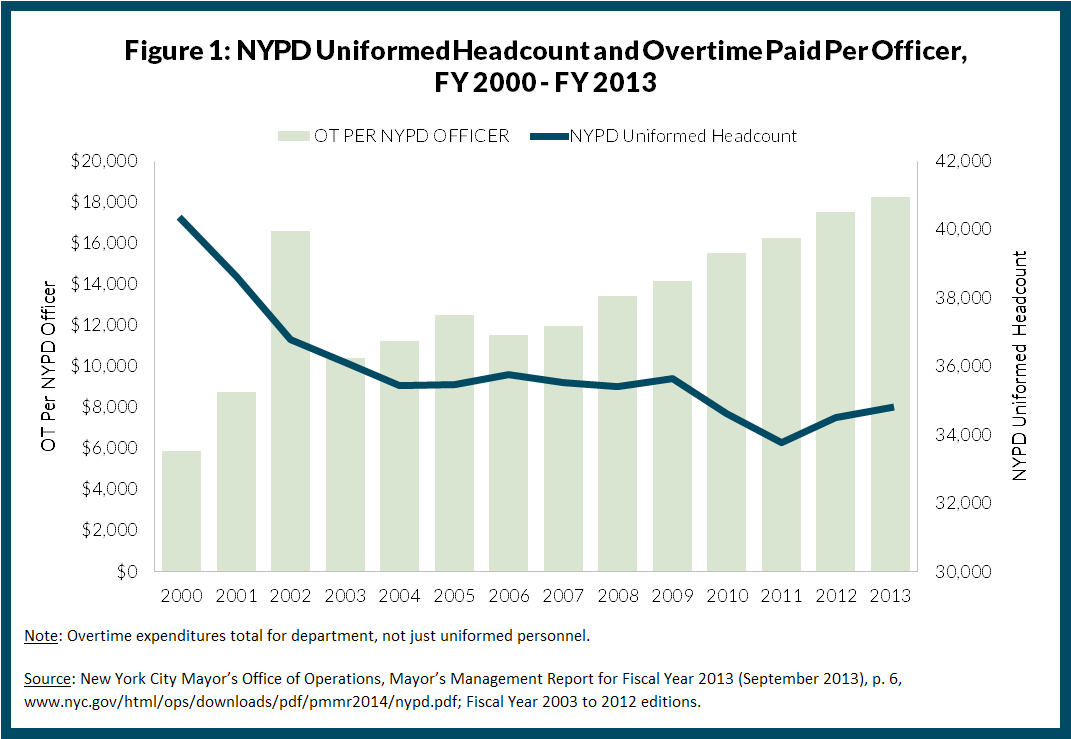Three Questions about 1,000 New Police Officers
As the New York City budget for fiscal year 2015 nears adoption, the City Council is negotiating with the Mayor to secure funding for its priorities, such as universal school lunches, legal services for evictees, and increased support for public libraries. One of the more expensive Council initiatives, at an estimated cost of almost $100 million annually,[1] is the hiring of 1,000 new police officers to increase staffing at police precincts.
In order to determine whether this initiative makes sense, it is useful to answer three questions:
Is the police department understaffed by 1,000 officers?
New York City has one of the most well-staffed police departments in the nation. Despite a decrease in uniformed police officers from a high of 40,285 in fiscal year 2000 to 34,804 at the end of fiscal year 2013, the New York City Police Department (NYPD) ranks fifth in staffing among departments in the 50 most populous U.S. cities.[2] For every 10,000 New Yorkers, there are 41.7 police officers in the NYPD; the average among the 50 cities is only 23.8. The cities with larger ratios are Washington DC (61.2), Baltimore (47.4), Chicago (44.1), and Philadelphia (42.4)—all with higher crime rates.
Will hiring more officers save money by reducing overtime expenditures?
The NYPD has been consistently unable to curb overtime expenses, which accounted for 13.6 percent of its $4.6 billion budget in fiscal year 2013. Overtime expenditures have increased dramatically, from $237 million in fiscal year 2000 to $635 million in fiscal year 2013.[3] Overtime per uniformed employee over that time period grew from approximately $5,900 to more than $18,000. Of course, fiscal year 2013 included expenditures related to Hurricane Sandy, but even without that emergency, the NYPD exceeded its overtime budget by an average of 41 percent over the last five years, and the City Council projects overtime in fiscal year 2014 will cost $580 million, one-third higher than the amount budgeted.[4]
It is possible that hiring new police officers will reduce overtime expenditures: patrol hours can be covered by the new officers during their regular shifts instead of by officers working overtime at 1.5 times the hourly wage rate. But if the new officers are assigned to patrol duty in higher crime precincts and not to provide security at events, such as parades, for which overtime is now scheduled, then they will not save money and may even increase overtime costs due to increased arrests. New hiring will not assure a reduction in overtime expenditures without an accompanying revision of overtime protocols.
Is there a more cost-effective way to increase patrol presence?
Some police officers perform administrative roles that could be filled by civilians. According to the City Council, 730 police officers perform civilian functions; hiring police administrative aids to free up 500 officers for patrol duty would cost $26.3 million annually[5]– half the projected expense of hiring the equivalent number of new officers.
Moreover, it is possible the responsibilities of these officers can be absorbed by current civilian personnel. Among police departments in the 50 most populous cities, the NYPD ranks first in the ratio of civilian employees to residents: 17.8 per 10,000 residents, more than double the 50-city average ratio of 6.6.[6] This suggests that savings are possible through administrative efficiencies and that many of the 730 officers on administrative duty could be reassigned to precincts without any additional hiring.
In sum, the answers to the three questions appear to be: No, Unclear, and Yes. If these responses are valid, then the case for adding 1,000 officers is weak; negotiations should instead be focused on ways to control overtime, moving officers performing civilian roles to patrol and administrative restructuring within the department.
Footnotes
- The City Council projects the cost, including fringe benefits, of hiring an additional 1,000 police officers to be $94.3 million in fiscal year 2015. The cost will rise steadily over time because police officers receive “step” increases and other longevity payments as they gain seniority on the force. Under the current contract, the salary of a newly hired police officer almost doubles to $80,377 from $41,975 after six years. In addition these estimates predate the settlement of the United Federation of Teachers contract that established a pattern for wage increases totaling 10.4 percent over seven years. If the Patrolmen’s Benevolent Association does not accept the pattern and the contract is settled in arbitration before the State Public Employment Relations Board, the wage increases could be even greater, making the City Council’s estimate very low.
- CBC analysis of data from the Federal Bureau of Investigation, Uniform Crime Reports: “Crime in the United States,” Table 78 (2012), www.fbi.gov/about-us/cjis/ucr/crime-in-the-u.s/2012/crime-in-the-u.s.-2012/tables/78tabledatadecpdf/table_78_full_time_law_enforcement_employees_by_state_by_city_2012.xls/view.
- New York City Mayor’s Office of Operations, Mayor’s Management Report for Fiscal Year 2013 (September 2013), p. 6, www.nyc.gov/html/ops/downloads/pdf/pmmr2014/nypd.pdf.
- The Council, City of New York, The City Council’s Response to the Mayor’s FY 2015 Preliminary Budget and FY 2014 Preliminary Mayor’s Management Report (April 23, 2014), p. 30.
- The Council, City of New York, The City Council’s Response to the Mayor’s FY 2015 Preliminary Budget and FY 2014 Preliminary Mayor’s Management Report (April 23, 2014), pp. 21-22.
- CBC analysis of data from the Federal Bureau of Investigation, Uniform Crime Reports: “Crime in the United States,” Table 78 (2012), www.fbi.gov/about-us/cjis/ucr/crime-in-the-u.s/2012/crime-in-the-u.s.-2012/tables/78tabledatadecpdf/table_78_full_time_law_enforcement_employees_by_state_by_city_2012.xls/view.

